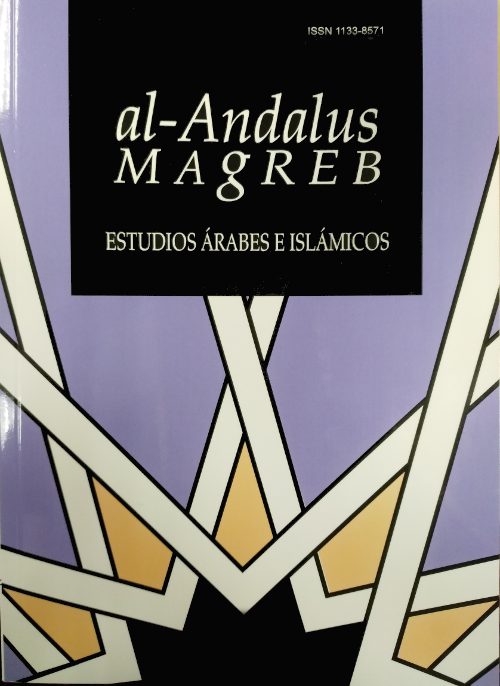Medical and fitotherapuetic vocabulary in Ḥassāniyya

Info
Abstract
This work contains a heterogeneous vocabulary of medical words as well as the names of some plants used en the Mauritanian traditional medicine. This vocabulary belongs to a tradition handed down orally over several centuries among the Mauritanian nomads and whose preservation is threatened today by the accelerated process of sedentarization in the country..
Keywords
Downloads
How to Cite
License

This work is licensed under a Creative Commons Attribution-NonCommercial-NoDerivatives 4.0 International License.
Those authors who have publications with this journal, accept the following terms:
a. Authors may retain their copyright and guarantee the journal the right of first publication of their work, which will be simultaneously subject to Licencia de reconocimiento de Creative Commons that allows third parties to share the work as long as its author is indicated. and its first publication this journal.
b. Authors may adopt other non-exclusive license agreements for the distribution of the version of the published work (eg: deposit it in an institutional electronic file) provided that the initial publication in this journal is indicated.
c. Authors are allowed and recommended to disseminate their work through the Internet (eg: in institutional telematic files or on their website) once the manuscript is accepted, which can lead to interesting exchanges and increase citations of the published work. (See El efecto del acceso abierto).
References
Álvarez-Millán, C. 1994. Abū l-ˁAlāˀ Zuhr, Kitāb al-muŷarrabāt (Libro de las experiencias médicas). Madrid. Fuentes Arábigo-Hispánicas, vol 17. Anawati, G. C. “Le traité d ́Averroes sur la theriaque et ses antecedents”,
Quaderni di studi arabi 5,6 (1988-88), págs. 26-48.
Awfā bnu Bābakkar al-hanṣawī aš-šamšawī al-ˀIdagfaġī, ˁUmdat aṭ-ṭabīb (copia
del ms. del autor de este artículo).
J. Bustamante, F. Corriente y M. Tilmatine. 2007. Abulḫayr AlˀIšbīlī (s.V/X/)
Kitābu ˁumdati ṭṭabīb fī maˁrifati nnabāt likulli labīb. Edición, notas y traducción castellana de J. Bustamante, F. Corriente y M. Tilmatine. Madrid. Consejo Superior de Investigaciones Científicas.
Corriente, F. / Ferrando, I. 2005. Diccionario avanzado árabe. Tomo I árabe- español. Barcelona. Herder.
Corriente, F. / Ould Mohamed Baba, A.-S. 2010. Diccionario avanzado árabe. Tomo II Español-árabe. Barcelona. Herder.
Ferrando, I./Sánchez J.J. (edts.) 2003. Aida 5th Conference Proceedings. Cádiz. Hitti, Y. K. 1982. Hitti ́s English-Arabic medical dictionary with an Arabic-
English vacabulary. Beirut.
Jacquart, D. & Troupeau, G. 1980. Yûḥannâ Ibn Māsawayh (Jean Mesue) Le
livre des axiomes médicaux (aphorismi). Edition du texte arabe et des
verions latines avec traduction française et lexique. Genève.
Jacquart, D. & Micheau, F. 1990. La médecine arabe et l ́occident médiéval.
París.
Kuhne, R. 1996. “La fruta ¿alimento o medicamento? Reflexiones sobre la
presencia de la fruta en la farmacopea árabe medieval”. Anaquel de
Estudios Árabes, 7, 69-86.
al-Maktab ad-dāˀim li-tansīq at-taˁrīb fī l-waṭan al-ˁarabī. 1971. Muˁǧam an-
nabāt. Rabat.
al-Maktab ad-dāˀim li-tansīq at-taˁrīb fī l-waṭan al-ˁarabī. 1977. Muṣṭalaḥāt ˁilm
aṣ-ṣiḥḥa wa-ǧism al-ˀinsān fī t-taˁlīm al-ˁāmm. Rabat.
an-Naḥwī, al-Xalīl. 1987. Bilād Šinqīṭ al-manāra wa-r-ribāṭ. Túnez.
Ould Hamidoun, M. 1952. Précis sur la Mauritanie. Saint-Louis.
Ould Mohamed Baba, A.-S. 1998. “Äṣl əl-Biān: Textos de Məḏḏärəḏrä
(Mauritania)”. Estudios de Dialectología Norteafricana y Andalusí, 3, 163-201.
Ould
Ould Ould
Ould
Ould
Mohamed Baba, A. S. 2003. “Emprunts du dialecte ḥassāniyyä à la langue française”. En Ferrando, I./Sánchez J.J. (edts.) Aida 5th Conference Proceedings, pp. 61-74.
Mohamed Baba, A.-S. 2006a. “Los fitónimos más frecuentes en el dialecto ḥassāniyyä”. Anaquel de Estudios Árabes 17, 173-187.
Mohamed Baba, A. S. 2006b. “Les euphémismes dans les dialectes arabes: le cas du ḥassāniyyä”. L ́arabe dialectal: enquêtes, descriptions, interprétations Actes d ́AIDA 6 Cahiers du CERES. Serie Linguistique no 13. Túnez.
Mohamed Baba, A. S. 2007. “isoglosas léxicas del dialecto ḥassāniyyä”. Anaquel de Estudios Árabes 18, 191-200.
Mohamed Baba, A. S. 2008. Refranero y fraseología ḥassānī. Recopilación, explicación, estudio gramatical y glosario. Zaragoza.
Pormann, P. E. & Savage-Smith, E. 2006. Medieval Islamic Medicine.
Edinburgh.
Puente, C. de la. 2003. Avenzoar, Averroes, Ibn al-Jatib médicos de al-Andalus.
Perfumes, ungüentos y jarabes. Madrid.
Renaud, H. P. J. & Colin, G. S. 1934. Tuḥfat al-Aḥbāb. Glossaire de la matière
médicale marocaine. París.
aš-Šinqīṭī. Aḥmad b. al-ˀAmīn 1911. Al-wasīṭ fī tarāǧim ˀudabāˀ šinqīṭ. El Cairo. Taine-Cheikh, C. 1989-. Dictionnaire Hassaniyya-Français. París.
Valverde, J. A. 2004. Sáhara, Guínea, Marruecos. Expediciones africanas.
Memorias de un Biólogo Heterodoxo. Madrid.
Varela Castro, C. S. et alii “Nota clínica larva migrans cutánea: diagnostico de
sospecha y tratamiento en atención primaria”, Medifam, vol. 12 n. 10,
Vázquez de Benito/Herrera, M. T. 1989. Los arabismos de los textos médicos
latinos y castellanos. Madrid. CSIC.
Vernet, J. 2001. Lo que Europa debe al Islam de España. Barcelona.
Wuld Bazayd, S. M. 1996. Maǧmaˁ al-muˀallifīn fī l-qiṭr aš-šinqīṭi. Sūsa.
Wuld Ismāˁīl, I. 1997. Tarāǧim al-ˀaˁlām al-mūritāniyyīn al-ǧuzˀ al-ˀawwal.
Nouakchott.


